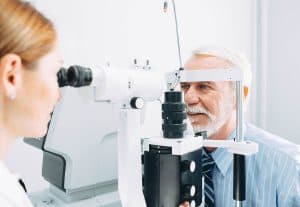
More individuals in this country have cataract surgery than nearly any other surgery. Cataract surgery success rates are very high, and the technology to perform the procedure continues to evolve and improve patient outcomes.
Though cataract surgery is very safe and routine, no procedure is completely risk-free. There is always a small chance of complications or side effects, even after a textbook-perfect procedure. In the case of cataract surgery, approximately 20% of cataract patients experience a perplexing complication that mimics the signs and symptoms of their original cataracts — prompting the question, “Have my cataracts returned?” The short answer is no, and a quick, swift, and pain-free follow-up procedure resolves the matter in minutes.
Laser Eye Center, one of the country’s leading destinations for cataract surgery, commonly sees patients who are puzzled and wonder if their cataracts have come back. We are happy to clear up the confusion and assure patients that cataracts cannot return.
Can You Get Cataracts Twice?
It is impossible to develop cataracts twice.
Cataracts are a clouding of the natural crystalline lens; they occur when proteins composing the lens start to clump together. During cataract surgery, the natural lens of the eye is removed. The artificial lenses (intraocular lens implants, or IOLs) used to replace the natural lenses cannot develop cloudiness like natural lenses can.
With that said, a small number of cataract surgery patients do experience symptoms consistent with cataracts in the weeks, months, and years after surgery. To understand why this happens, it helps to have a basic understanding of the eye’s anatomy (particularly the lens and structures immediately surrounding it).
The eye’s crystalline lens is held in position by a thin membrane, known as the lens capsule. During cataract surgery, a small opening is created in the lens capsule to access the lens. Once the lens has been carefully fragmented, the pieces are removed from the lens capsule. But the anterior capsule remains in place and is responsible for supporting the new IOL and holding it in place.
What Causes Cloudy Vision After Cataract Surgery?
Approximately 1 in 5 cataract patients develop “secondary cataracts,” which describes a set of symptoms nearly identical to what they experienced from primary cataracts. But the cataract has not, in fact, returned after surgery.

The most common explanation for the return of symptoms is that the patient has a condition termed posterior capsular opacification. This refers to a clouding or a fogginess of the posterior of the capsule. What can happen is that small amounts of epithelial cells from the natural lens can remain in the lens capsule after cataract removal, and start to multiply and clump together over time. This can cause the opacification of the back of the capsule, which impedes incoming light from passing through the lens and reaching the retina.
The signs and symptoms of posterior capsular opacification are usually very similar to that of a primary cataract. In addition to blurry vision, symptoms of posterior capsular opacification can include the following:
- Overall diminished quality of vision
- Sensitivity to light
- Glare
- Halos around bright lights
- Diminished contrast sensitivity
- Trouble reading
Diagnosing and Treating Posterior Capsular Opacification
Some blurriness can be expected right after cataract surgery. However, generally this blurriness subsides within a week or so of treatment. If it does not resolve, an evaluation by an eye doctor is recommended.
Diagnosis

Secondary cataracts are diagnosed in consultation with an ophthalmologist. If you are experiencing symptoms consistent with cataracts after your cataract surgery, you should schedule an appointment with the team who performed your surgery or with another experienced, reputable eye doctor in your area. During your appointment, the doctor will ask you about your cataracts, cataract surgery details, and any other relevant factors in your ocular health history. You will also be asked to describe the symptoms you are currently experiencing and to approximate when you first noticed them.
Next, the doctor will examine the inside of your eyes with an instrument called a slit lamp. This is a type of lighted microscope that allows the doctor a clear look at the internal structures of your eye. (The slit lamp examination is not painful or uncomfortable.) The doctor can evaluate the membrane holding the IOL in place and almost immediately determine whether posterior capsule opacification has developed.
Treatment
The majority of cases of posterior capsular opacification are treated with a laser procedure called YAG laser capsulotomy. Conventional surgery to treat posterior capsular opacification is very rare. YAG laser capsulotomy can be performed during a quick office visit.
It is a fast, easy, and pain-free procedure, and it takes less than five minutes.
During YAG laser capsulotomy, the doctor uses a YAG laser to create a miniscule opening in the capsule holding the IOL. This opening serves as a path for incoming light to pass through the lens capsule and onto the retina, where it is properly focused.
There is a short observation period after YAG laser capsulotomy to monitor intraocular pressure and ensure it does not become elevated. After that, the patient is released to go home.
Nearly all patients with posterior capsular opacification see a vast improvement in visual quality after YAG laser capsulotomy. It is extremely rare for posterior capsular opacification to recur or to require an additional corrective procedure.
Risk Factors for Secondary Cataracts
Though any cataract patient can develop secondary cataracts, certain factors increase the risk.
Risk factors include:
- History of diabetes
- History of certain eye conditions, such as uveitis and retinitis pigmentosa
- History of surgery for glaucoma or retinal conditions
Being younger in age is another risk factor for secondary cataracts. Although most cataracts are age-related and develop in individuals over the age of 60, they can be congenital or occur during early childhood. Perhaps paradoxically, those under the age of 60 at the time of cataract surgery are more likely to develop secondary cataracts.
Getting Help for Secondary Cataracts
If you suspect secondary cataracts in the months or years following your surgery, it is imperative to seek the help of a reputable ophthalmologist. You need someone who is extremely well-versed in the diagnosis and treatment of posterior capsular opacification, and who has performed the YAG laser capsulotomy procedure many times.
Laser Eye Center is home to some of the nation’s most esteemed cataract surgeons, and we see and treat patients with secondary cataracts on a regular basis. We can quickly diagnose the problem and offer immediate intervention, so you do not have to live with ongoing cloudy vision.
If you would like to schedule an evaluation with a member of our team, please reach out to us promptly.
Schedule your free consult today
Click here to learn moreGet started on your journey to clearer, crisper vision with Laser Eye Center™. Our expert team of doctors are trained and skilled in the latest technology and methods for laser vision correction. To learn more about our state-of-the-art All Laser LASIK technology or about All Laser LASIK itself, contact us today. Schedule your FREE All Laser LASIK consultation by calling today.

